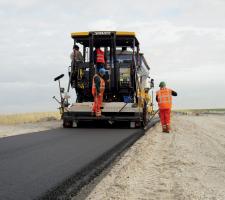
Roads, wherever they are, represent major public investment and for this reason are expected to last for a long time. Rapid increases in the number of vehicles and thus a rise in traffic volumes and axle loads produce congestion, wear and tear on structures, along with air pollution and noise emissions. The materials used to construct modern roads, from the sub-base upwards to the asphalt or concrete wear surface have improved vastly over the years, as has the equipment involved.
In the Netherlands, Kuiken,
The team involved visited six different customers, travelled more than 1,700km and clocked up more than 60 hours of paving.
The machine was loaded onto a transport truck and driven to the six different sites at the request of customers and construction companies, so that Kuiken’s dealership team could perform comprehensive machine demonstrations.
Kuiken had access to the machine for two weeks and it asked customers to choose a location where they wanted the team to demonstrate the machine paving.
The team from the dealership spent nine hours a day on average with every customer, starting before 6am to heat the machine’s screed.
Meanwhile, since being established in 1996, Ashmac Construction has completed over 750 capital schemes for local authorities and over 40 major schemes for central government in the UK including contracts for roads, park and ride schemes, car parks, bridgeworks and town centre environmental enhancement schemes.
It recently took delivery of a Volvo ABG 6870 following a successful demonstration and evaluation of the machine which came in for close scrutiny by director Greg Emonds and his team.
The paver features continuous independent traction control over all six wheels and powered by a Tier III 122Kw engine, and the operator is able to use the Smart Power setting to vary the power output depending on the conditions of the application. “Even on the most difficult bases, tractive effort is automatically adjusted according to ground condition and the weight of material available in the machine’s 12tonne capacity hopper,” says Volvo CE.
The paver features Active Steering with an inside turning radius of 2.5m, and a variable screed width of between 2.5-5m in standard configuration but can be fitted with optional extensions to provide a generous width of 9m.
“With an output potential of up to 700tonnes per hour, the machine can continuously pave up to 40m per minute. While a normal layer thickness of 50mm at high speed is easily achievable, the ABG6870 can lay, for certain applications, up to maximum thickness of 300mm,” says Volvo CE.
“I know how important the speed and accuracy of the screed is to the crew, as coming up from the tools myself and being an operator in the past and being around different pavers for most of my working life it can add hours on to each shift,” says Emonds.
The ABG6870’s EPM (Electronic Paver Management) control panel has backlit control buttons to aid paving at night.
Ashmac Construction’s ABG6870 has been working entirely on a prestigious joint venture contract for (County) Hertfordshire Highways, south-east England, which entails road maintenance and renewals across the county.
The maintenance of roads in historic districts is a challenge for communities around the world, and the need to respect the surroundings limits the amount of re-engineering and widening that can be considered.
In the city of Florence, Italy, streets in its District 5 were deteriorating rapidly but comprehensive changes were out given the footprint of the roads in relation to the historic surroundings, so the city came up with an innovative plan, giving paving contractor AVR complete control of the repairs.
AVR monitored road conditions in a variety of ways. Its staff identified critical hot spots and it created a 24-hour call centre that could be accessed by the police and the local council as well as AVR staff who reported potholes and other obstructions.
The reports were classified and the most critical findings were registered as an emergency with remedial action required within 45 minutes. Findings that were not urgent had to be addressed within three working days.
AVR conducted its own safety analysis of the road network to identify potentially dangerous areas and prioritised the work.
One District 5 street, Viale Corsica became a priority after its deterioration meant it needed repairing rather than patching, with the most urgent repairs required in the bus lane.
Work had to be completed fast to cause minimal disruption to thousands daily bus users and the adjacent traffic lane had to remain open.
AVR chose the
“We milled and rebuilt 4cm of mat over a length of about 350m and a width of 12m,” says Lorenzo Porciani, AVR manager.
AVR monitored the Viale Corsica project closely as did the city of Florence officials with work on the street being used as a test of how the equipment would handle necessary repairs on other narrow streets.
The project was successful and now medium to large projects (above 100m² of extension) use the same equipment plus Cat CB34XW and CB434D rollers.
The scope of the work has proven to be a success for both AVR and the city of Florence. In six months more than 5,000 potholes were filled in District 5, including 143 emergency patches. In addition, more than 84 milling and repaving operations took place in 20 different district streets.
Since the launch, the ZX250LC-5, ZX290LC-5 and ZX350LC-5 medium excavators, and ZX670LCH-5 and ZX870LCH-5 large machines have been delivered to a wide range of customers for their first assignments all over Europe by HCME.
One of the first machines to break cover was a ZX250LC-5 working for Trafikk & Anlegg on the E18 road construction project between Sandefjord and Tønsberg in Norway. Andres Sœtre has 30 years’ experience of operating excavators and has worked with two other Hitachi models, a ZX160W and ZX210-3.
“My initial impressions are that the changes between the Zaxis-3 and -5 excavators are all positive,” says Andres.
“The TRIAS hydraulic system is especially good, as are the swing torque and enhanced performance of the engine. The seat is comfortable; the controls are within easy reach; and there’s less noise and more legroom in the cab.”
The Kaliningrad motorway Primorsk Ring is one of the prestige projects currently under construction as part of Russia’s infrastructure improvement programme, and with a total length of approximately 180km, of which 81km are motorway, the ring road will encircle the 500,000-resident city of Kaliningrad in a broad arc around the Samland peninsula.
Completion of the 1 billion rouble (€25 million) project is scheduled for 2015 and should facilitate comfortable travel for residents, tourists and football fans travelling to the 2018 World Cup football venue in Kaliningrad.
Four sections have already been opened to traffic and a fifth section is currently under construction.
For ZAO VAD, the construction consortium performing the work, precise and error-free construction of the road has top priority, and to accomplish this, the right material composition, material temperature, smooth paving process and then a precise compaction of the asphalt are necessary.
“During road construction, it is very important that work be performed exactly and painstakingly from the first to the last work step. Compaction of the paved material is one aspect that plays a key part for a successful result,” says Ronald Brinks from ZAO VAD.
The company, in cooperation with OOO SMD Balt Avtomatika, installed the MOBA Compaction Assistant system (MCA-2000) on a roller.
“The requirement in this project was to make the compaction more controllable as, in the past, this was based solely on the experience of the worker and there was no continuous monitoring of the results,” says Yuri Dolgilevitch from OOO SMD Balt Avtomatika.
“Moreover, it had to be possible to create a quality certificate for the performed compaction work. That is why we decided to use the MCA-2000.”
It is said that by using the MCA-2000, the material can now be compacted in a more controlled manner and much more precisely.
The system uses temperature sensors to measure the temperature of the paved asphalt. This information appears directly on the display and the roller operator can use it to compact in precisely those areas where the temperature is in the optimum temperature range from 100-140ºC.
“During comparison measurements, the temperature displayed by the system was identical to the temperature that we measured and thereby facilitates a reliable temperature measurement,” says Yuri Dolgilevitch.
This prevents asphalt that is either too cold or too hot from being compacted, because this can lead to material damages and, thus, to a reduced road quality.
In addition to the temperature, the system also records the passes of the roller by means of GPS positioning and compares the target and actual passes.


















